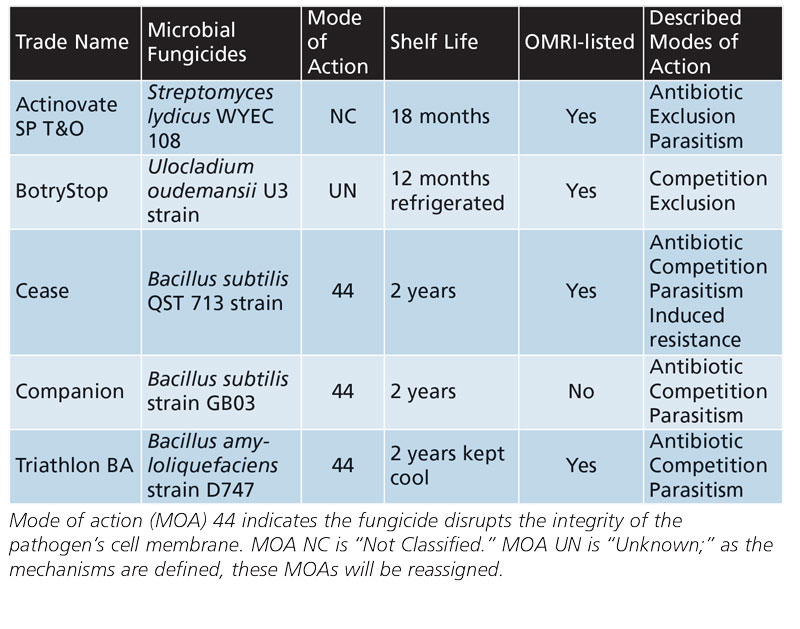4/1/2019
The Microbes Move In
Karen Stever
Last year’s wet, cool spring gave growers ample reason to apply a fungicide. At some points, the GGSPro technical services team could have answered the phones with, “Botrytis Central. How can we help?” To be sure, we recommended applications of traditional foliar fungicides to many, many growers of ornamentals during that time.
During times of heavy disease pressure, choosing and rotating the proper fungicides can be challenging. Growers may be tempted to skimp, using fewer products at a lower investment than the recommended full rotation of at least three products, which is known to delay chemical resistance.
This is just one situation wherein biological fungicides really show their utility! If you grow organic and/or edible crops, you may already rely heavily on the use of microbial fungicides, but please continue reading to learn how these products work and to see the latest introductions in this class.
Five “whys” of biological fungicides
Why might a grower, with all the chemical options available to them, choose a fungicide based on a bacterium or fungus?
1. Microbial fungicides have broad labels allowing them to be used on all ornamentals and almost all edible crops. The list of diseases controlled is often broad, further increasing the products’ utility.
2. A reduced risk of pesticide resistance is expected, due to the modes of action of these microbial fungicides. Furthermore, using biologicals helps to preserve the activity of traditional chemicals by reducing how often they’re needed and used.
3. All of these fungicides have short re-entry intervals (REIs) and modest amounts of personal protection equipment (PPE) are required. These facts signal their relative human safety and make them easier to use.
4. The costs are reasonable; there’s no premium for the advantages listed above.
5. Lastly, the buying public wants our industry to use the safest products available. These products fit that charge.
Five “hows” of biological fungicides
How do biological fungicides work? Often, the organisms work through more than one mode of action, a helpful trait in terms of fending off pesticide resistance. “Fending off” is an apt description for some of the more common modes of action, which include:
• Antibiotic: The organism produces compounds that inhibit the plant pathogens, e.g., compounds that inhibit fungal and bacterial spores from germinating.
• Competition: The beneficial organism depletes the treated area of resources needed by the pathogen and thereby out-competes it for that location.
• Exclusion: In this case, the beneficial organism populates the surface of the plant tissue, growing and physically excluding the pathogen.
• Parasitism: The beneficial organism feeds directly on the pathogen, inhibiting it or killing it altogether.
• Induced resistance: The organism activates signaling pathways in the plant, leading to an immune-like response in the plant.
 PVent is a relatively new microbial fungicide from BioSafe. It’s based on a unique strain of Gliocladium fungus and will be registered for many foliar diseases including Botrytis.
PVent is a relatively new microbial fungicide from BioSafe. It’s based on a unique strain of Gliocladium fungus and will be registered for many foliar diseases including Botrytis.
Other attributes microbial fungicides hold in common:
• These products are considered primarily preventative fungicides.
• When treating an active infection, when possible, use a knock-down product followed by the microbial.
• Tank-mixing is possible with a wide selection of other fungicides and insecticides.
• Do not tank-mix with fungal-based insecticides (e.g., Ancora, BioCeres, BotaniGard).
• Do not tank-mix with a bactericide, except as allowed on the label.
• These products have excellent plant and bloom safety.
• With the exception of BotryStop, products are also labeled for root and crown rot drench applications.
To ensure maximum success with these microbial fungicides, first compare labels to confirm they’re suitable for the diseases you wish to control. They’re relatively short-lived on leaf surfaces, so pay close attention to re-application intervals and apply before disease is active.
As with other types of fungicides, it’s essential to manage the growing environment to minimize disease pressure. Even the best fungicides will fail if growing conditions are favorable for disease development. Always read and follow all label directions. Products other than those mentioned here may also be safe and effective. GT
Karen Stever is a GGSPro Technical Support Representative for Griffin. She can be reached at ggsprotech@griffinmail.com.